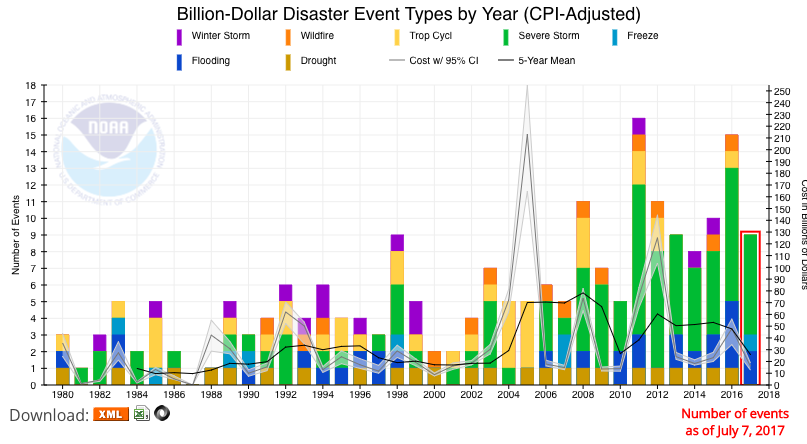This morning in the New York Times, columnist Bret Stephens braved the slings and arrows of the climate commentariat and took a look at how we bear the costs of natural disasters. The piece aims to unpack why, despite the horrifying pictures we see in the papers, the flooding after Harvey seems relatively minor. For example, the death toll from Harvey flooding has been (gratefully) modest compared to the thousands perishing from a monsoon flooding in India and neighboring countries. Stephens goes through some other examples, but the basic point is that wealth is a really good way to build resilience against stressful events like natural disasters.
All that wealth means that we now measure the cost of these events in ever increasing dollar amounts. In the U.S., that is pretty clear from the NOAA billion dollar disaster database.
But there are outstanding questions about how and why those dollar figures are going up. Is it that a wealthy society just has more to lose? Is there some marginal effect from climate change making their impacts worse? Or, as Roger Pielke Jr has argued and Stephens embraces, is the size of these damages decreasing with respect to GDP even as they grow in dollar signs? That might indicate that we are getting more resilient as we get wealthier.
That last conclusion gives many the impression that we can grow our way out of environmental risks. I don’t want to ascribe that belief to Stephens but many hold it and argue that therefore we shouldn’t do things that risk growth (like mitigate CO2 emissions) because growth salves all. So while I agree it is better to be rich rather than poor when a few feet of water are running by your house, I think we should be careful to not let that fix how we think about the relationship between hurricanes, growth, and climate.
One big question is how much lasting effect do these events have and, in the context of climate change, whether that effect will get worse. Stephens posits that Harvey will have a small lasting effect.
The numbers are likely to be staggering in absolute terms, but what’s more remarkable is how easily the American economy can absorb the blow. The storm will be a “speed bump” to Houston’s $503 billion economy, according to Moody’s Analytics’ Adam Kamins, who told The Wall Street Journal that he expects the storm to derail growth for about two months.
How should we think about the idea that we can just outgrow these massively damaging events or that they are just speed bumps for progress?
There is some evidence that such events are not just speed bumps. This NBER working paper from Hsiang and Jina looked at historical data for 6700 cyclone events and compared impacted countries growth rates before and after such storms. The abstract tosses the “speed bump” theory out the window:
We compare each country’s growth rate to itself in the years immediately before and after exposure, accounting for the distribution of cyclones in preceding years. The data reject hypotheses that disasters stimulate growth or that short-run losses disappear following migrations or transfers of wealth. Instead, we find robust evidence that national incomes decline, relative to their pre-disaster trend, and do not recover within twenty years. Both rich and poor countries exhibit this response, with losses magnified in countries with less historical cyclone experience.
Unsurprisingly, the long-lasting growth effects are largest for the biggest events. Fifteen years after the largest events, the lasting damage has the effect of removing 3.7 years of growth. That data really knocks out the ‘speed bump’ idea. A cursory browse of citations in google scholar doesn’t reveal a strong counterpoint.
From here we can get more speculative. Hsiang and Jina calculate how that relationship might affect continued economic growth in the 21st century, as climate change continues and storms get more damaging. To estimate more damaging, they use a modeled increase in tropical cyclone intensity under a very high emissions scenario. The net present value of the losses due to climate change affecting cyclones is large: 9.7 trillion dollars today.
Now there are a lot of qualifications to that number. Those hurricane models are pretty uncertain, climate change might make impacts worse in other ways than higher intensity, and we don’t know that the econometric relationship between growth and cyclone incidence will remain constant. So caveat emptor.
But the size of that number has interesting implications. BNEF estimates that we only need an additional $5.2 trillion of investment to get on a 2°C path over the next couple of decades. If that $9.7 trillion number could be decreased by half or more by getting on that 2°C path, then we could save future generations a lot of pain through climate action. And it would be worth it almost entirely because future generations would experience fewer damaging cyclones and more economic growth.
